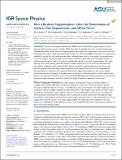Files in this item
How a realistic magnetosphere alters the polarizations of surface, fast magnetosonic, and Alfvén waves
Item metadata
| dc.contributor.author | Archer, M. O. | |
| dc.contributor.author | Southwood, D. J. | |
| dc.contributor.author | Hartinger, M. D. | |
| dc.contributor.author | Rastaetter, L. | |
| dc.contributor.author | Wright, A. N. | |
| dc.date.accessioned | 2022-02-08T17:30:01Z | |
| dc.date.available | 2022-02-08T17:30:01Z | |
| dc.date.issued | 2022-02 | |
| dc.identifier | 277692514 | |
| dc.identifier | 7c1c4b68-b9b7-4f1c-a5bd-85ec55e66182 | |
| dc.identifier | 85125413659 | |
| dc.identifier | 000765721800045 | |
| dc.identifier.citation | Archer , M O , Southwood , D J , Hartinger , M D , Rastaetter , L & Wright , A N 2022 , ' How a realistic magnetosphere alters the polarizations of surface, fast magnetosonic, and Alfvén waves ' , Journal of Geophysical Research: Space Physics , vol. 127 , no. 2 , e2021JA030032 . https://doi.org/10.1029/2021JA030032 | en |
| dc.identifier.issn | 2169-9380 | |
| dc.identifier.other | RIS: urn:A954427144DDE77C59CEC8BA666589B8 | |
| dc.identifier.other | ORCID: /0000-0002-9877-1457/work/108118658 | |
| dc.identifier.uri | https://hdl.handle.net/10023/24827 | |
| dc.description | Funding: MOA holds a UKRI (STFC / EPSRC) Stephen Hawking Fellowship EP/T01735X/1. DJS was supported by STFC grant ST/S000364/1. MDH was supported by NASA grant 80NSSC19K0127. A.N.W. was partially funded by STFC grant ST/N000609/1. | en |
| dc.description.abstract | System-scale magnetohydrodynamic (MHD) waves within Earth?s magnetosphere are often understood theoretically using box models. While these have been highly instructive in understanding many fundamental features of the various wave modes present, they neglect the complexities of geospace such as the inhomogeneities and curvilinear geometries present. Here we show global MHD simulations of resonant waves impulsively-excited by a solar wind pressure pulse. Although many aspects of the surface, fast magnetosonic (cavity/waveguide), and Alfvén modes present agree with the box and axially symmetric dipole models, we find some predictions for large-scale waves are significantly altered in a realistic magnetosphere. The radial ordering of fast mode turning points and Alfvén resonant locations may be reversed even with monotonic wave speeds. Additional nodes along field lines that are not present in the displacement/velocity occur in both the perpendicular and compressional components of the magnetic field. Close to the magnetopause the perpendicular oscillations of the magnetic field have the opposite handedness to the velocity. Finally, widely-used detection techniques for standing waves, both across and along the field, can fail to identify their presence. We explain how all these features arise from the MHD equations when accounting for a non-uniform background field and propose modified methods which might be applied to spacecraft observations. | |
| dc.format.extent | 23 | |
| dc.format.extent | 8597218 | |
| dc.language.iso | eng | |
| dc.relation.ispartof | Journal of Geophysical Research: Space Physics | en |
| dc.subject | Ulf waves | en |
| dc.subject | Polarization | en |
| dc.subject | Magnetohydrodynamics | en |
| dc.subject | Simulation | en |
| dc.subject | Theory | en |
| dc.subject | QA Mathematics | en |
| dc.subject | QB Astronomy | en |
| dc.subject | QC Physics | en |
| dc.subject | DAS | en |
| dc.subject.lcc | QA | en |
| dc.subject.lcc | QB | en |
| dc.subject.lcc | QC | en |
| dc.title | How a realistic magnetosphere alters the polarizations of surface, fast magnetosonic, and Alfvén waves | en |
| dc.type | Journal article | en |
| dc.contributor.sponsor | Science & Technology Facilities Council | en |
| dc.contributor.institution | University of St Andrews. Applied Mathematics | en |
| dc.identifier.doi | https://doi.org/10.1029/2021JA030032 | |
| dc.description.status | Peer reviewed | en |
| dc.identifier.grantnumber | ST/N000609/1 | en |
This item appears in the following Collection(s)
Items in the St Andrews Research Repository are protected by copyright, with all rights reserved, unless otherwise indicated.

